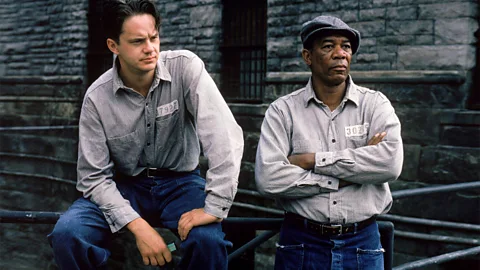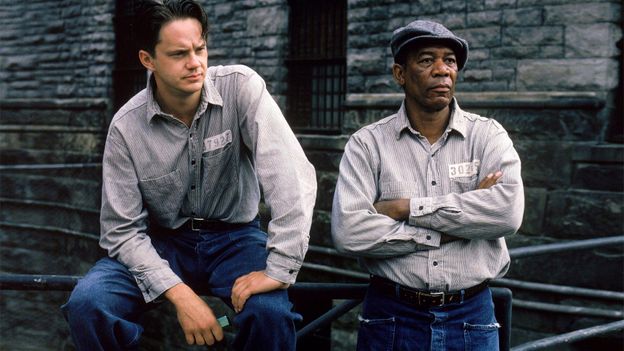 Alamy
AlamyWhen The Shawshank Redemption came out 30 years ago this week, it seemed to have all the ingredients of a box-office smash.
After all, it was based on a novella by one of the world’s best-selling authors, Stephen King, so it looked as if a ready-made fanbase would be interested in seeing it. Indeed, another story, The Body, taken from the same 1982 collection, Different Seasons, had been turned into a hugely successful movie, Stand by Me, in 1986. Director and screenwriter Frank Darabont believed that the story was so filmic that in 1987 he bought the rights to adapt it himself. “I found the story, Stephen King’s story, so compelling, really, and so touching that to me it was just natural as a movie,” he told Stuart Maconie on BBC4 programme The DVD Collection in 2004.
The novella told the story of Andy Dufresne, a man convicted of murdering his wife and her lover, and how, through his friendship with fellow inmate Ellis “Red” Redding, he survives, and ultimately triumphs over, the brutally harsh conditions of Shawshank Penitentiary. And Darabont had found the perfect location to stand in for the merciless, gothic prison. Ohio State Reformatory had opened in 1896 and been active up until 1990 when it closed due to allegations of inhumane treatment of its prisoners. Filming there would add an authentically grim atmosphere to The Shawshank Redemption. “You can’t really have a place like that without there being a real sense of foreboding and despair that sinks into that stone,” said Darabont. “And everybody felt it, everybody in the cast and the crew felt it. So, it was a very oppressive place to shoot a movie. People would say you feel the sadness in the place or you feel the ghosts in the place.”
The production had also pulled in two acclaimed actors for its starring roles. Tim Robbins, who was playing Dufresne, had received two Golden Globe nominations for different performances the year before, winning best actor for The Player. Morgan Freeman, cast as Red, had at the time already been Oscar-nominated twice. He was also hot off the back of appearing in Clint Eastwood’s 1993 western, Unforgiven, a film which had, along with achieving box-office success, won four Oscars.
And when the prison-set drama was finished, the early buzz was extremely promising. The film’s producer, Liz Glotzer, said that the audiences’ reactions to its test screenings were incredible. “I mean, they were the best screenings ever,” she told Vanity Fair in 2014. So, hopes were understandably high when The Shawshank Redemption was released in September 1994. Then, as Freeman told the BBC’s Graham Norton Show in 2017, “it tanked at the box office”. Darabont had told Maconie that the movie “had trouble finding our audience, getting people to show up”. Ticket sales of its initial theatrical run were distinctly underwhelming, only managing to recoup $16 million of its $25-million budget in the US.
The timing of the film’s release meant that it faced some stiff competition for viewers’ attention. The Shawshank Redemption came out in the middle of the wildly successful cinema run of the Tom Hanks hit Forrest Gump. Quentin Tarantino’s Pulp Fiction, which had won the Palme d’Or award at the Cannes Film Festival, came out just a couple of weeks later. These films were not just critical and commercial successes but became pop-cultural phenomena. Their quotable dialogue, striking cinematography and jukebox soundtracks generated reams of media coverage and they each offered talking points about the state of America at the time, overshadowing The Shawshank Redemption’s more introspective storyline.
Of course, the bleak premise and lack of female characters may have also made it a less obviously appealing choice to cinema-goers than the high-profile blockbusters which had already come out that summer, such as The Lion King, True Lies, Speed and The Mask. While the Academy did recognise the film, nominating it for seven awards including best actor for Freeman and best picture, ultimately it came away with nothing. Forrest Gump proved to be the big winner on the night, picking up six Oscars, with Pulp Fiction winning one for best screenplay.
The power of hope
Freeman himself put the movie’s initial box-office failure down to its name. “The only real marketing that movies get I think is word-of-mouth,” he told The Graham Norton Show in 2017. “Although people went to see The Shawshank Redemption and they came back and [said], ‘Oh man, I saw this really terrific movie, it’s called the… er… Shanksham? Shimshawnk?’ One lady saw me in the elevator one time and said, ‘Oh, I saw you in the Hudsucker Reduction’. So, if you can’t get word across, then it just doesn’t do well.”
But The Shawshank Redemption was to have its own redemption arc, as it found a new life in the home-video market. With its release on VHS, the film’s story of human resilience, friendship and the power of hope resonated with an audience that had missed it at the movie theatre. “We became the most rented video of 1995. Just boom, boom. And then that word-of-mouth from that audience began to grow and grow and grow,” Darabont told the BBC in 2004.
From 1997, its frequent broadcasts on cable television helped it to reach an even broader audience. By the time Darabont appeared on the BBC in 2004, The Shawshank Redemption was repeatedly appearing on lists of the “greatest” movies, including being voted the best film “never to have won an Oscar” in a poll by the BBC’s Radio Times. On the Internet Movie Database’s (IMDb) list of top 250 films, voted by regular users, it currently sits at the top above The Godfather. “And what’s really bizarre is that momentum never really seems to have died out. It has just kind of continued. Which is wonderful. It’s a fantastic vindication, really, for the film, isn’t it,” said Darabont.
During those first 10 years after the film’s release, the rapid uptake of the internet saw burgeoning communities of fans discuss and deconstruct the movie’s themes and imagery online. One theory that was popular at the time was that The Shawshank Redemption was a religious allegory and that the enigmatic Dufresne character represented Jesus Christ. But the film can – and has – been interpreted through a variety of framings including that it is anti-religious or even that it represents Jean-Paul Sartre’s form of existentialism.
The BBC’s Maconie asked Darabont if he had the story of Christ in his “mind even remotely” when making the film. “Yes, a little, in some measure, the religious parable of it, the parallels did occur to me, but not quite to the degree that’s been read into it,” said Darabont. “You know, suddenly, I read something like, you know, Tim [Robbins] has a line in it where he says, ‘Well, and I use this library to help a dozen guys get their high school diplomas,’ and suddenly the symbolism of that becomes, well, those are twelve apostles! And I think, ‘Boy, that never occurred to me, not in a million years did that occur to me,’ but that’s the pleasure for me of making a film that has some interpretation.”
Perhaps the biggest latter-day endorsement of The Shawshank Redemption’s enduring appeal, and the fans who championed it, came in 2015 when the Library of Congress added it to the US National Film Registry which represents “important cultural, artistic and historic achievements in film-making”.
“I express my deepest thanks to all those who chose it for inclusion in the National Film Registry,” said Darabont, “and most of all to the audiences who embraced our movie and have kept it alive all these years.”
For more stories and never-before-published radio scripts to your inbox, sign up to the In History newsletter, while The Essential List delivers a handpicked selection of features and insights twice a week.

